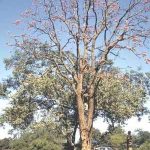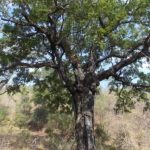TREE LIFE
JUNE 1981
MASHONALAND CALENDAR
Saturday June 6th : Botanic Garden Walk. (this is instead of the 1st Tuesday of the month as the sun goes to bed so early now). Meet in the Car Park at 1100 hours.
Sunday June 21st : Spelonken, Home of Hal and Marge Burrows. A return to the upper reaches of the Mazowe Dam. Bus leaves Monomatapa Car Park at 0900 hours. There will be a Security Guard at the Monomatapa Car Park. Fare $2.50.
Saturday July 4th : Meet in the Botanic Garden car park for another stroll through the gardens. I hope will have a look at some of the trees we expect to see on our next trip. Meet at 1100 hours.
Sunday July 19th : Wedza Mountain. Will need to make an early start so bus will leave at 0800 hours.
Sunday 16th September – an extra. Binga Swamp Forest, Arcturus. Own transport. Come for the morning, afternoon or full day. Included later on are some notes from Dick Petheram about the latest position at Binga and I am delighted we shall have the opportunity of sharing this beautiful piece of forest with everyone.
Botanic Garden Walk on Tuesday 5th May
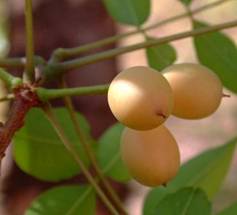
Zanha golungensis. Photo: Rob Burrett. Source: Flora of Zimbabwe
With a trip to the Shamva area coming up we had a look at some of the species we could expect to see. Meg Coates Palgrave had done a recce to the area and discovered Zanha golungensis, a rare find for our Mashonaland trips. This species and Z .africana belong to the Sapindaceae (the soap-berry and lichi family). Zanha golungensis is typically a forest edge species, reaching an enormous size in Mozambique. Z. africana occurs more often on drier kopjes. We could not agree exactly on how to distinguish the two species, though the leaf of the forest species was rather more wavy.
Pericopsis angolensis (formerly Afrormosia angolensis) is fairly common in the Shamva area. It is a very valuable timber tree, the timber still being referred to as ‘afrormosia’. It is easily distinguishable by its very long whitish barked trunk and dull green crown, and for closer inspection, the terminal leaflet which is the largest and is held at an angle, is characteristic.
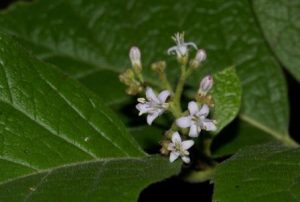
Ehretia obtusifolia. Photo: Bart Wursten. Source: Flora of Zimbabwe
We then tried to sort out the three Ehretia species (family Boraginaceae). They are for a start not always easy to distinguish from Cordia, the only other genus of the family occurring here.
Ehretia cymosa is also a forest edge species and it was in flower. The leaves of this species are generally larger than those of E. rigida and E. obtusifolia. The former we found to have smooth leaves, the latter very rough.
FOOTNOTE: Incidentally, Mr. Bob Drummond has examined more specimens and on further reflection has decided that all the specimens we found at Denby were E. obtusifolia and that we did not find E. rigida at all. No wonder we were confused!
The last Newsletter invited members to visit Bythern, Woodlands and Ceres Farms in the Shamva District. As there was such a variety and magnificence of trees on the aptly named Woodlands Farm we spent the whole day there and merely drove through Bythern and only stopped briefly to admire an enormous Flacourtia indica in the forest on Ceres. And as an extra treat the large leaved Cordias were still flowering. It would have been worth the visit just to see those.
Cordia abyssinica as it is more properly known is not very common nor very widespread being confined to warm moist forest areas. However, it is such a fast growing tree suitable for gardens that a number of people are familiar with it. In our gardens it is still has a lot of growing to do to reach the magnificent proportions of those we saw at Woodlands. Another inhabitant of forest type flora which we do not often see was Zanha golungensis. There was one particular tree which we estimated would have taken three people with arms outstretched to span its circumference. It is interesting that we found Z. africana, with which we are more familiar, in the same habitat and this will be further investigated as it is very unusual for find both species together. The really diagnostic feature between the two are the hairs on the fruit of Z. africana and lack of them on Z. golungensis. The fruiting times of both species are November to January. Incidentally the sexes are separate on different trees so if you know one which never fruits this may be the explanation. There is also controversy as to whether the fruits are edible – any volunteers? This genus is a member of the family Sapindaceae and so are Allophylus africana and Dodonaea viscosa which we also saw. The old round fruits of A. africana put paid to any argument that it might be a Rhus despite the lack of hairy pockets in the axils of the veins. Dodonaea was in flower and if only I had realised that this also can be dioecious I would have examined the flowers more carefully. In retrospect the one I did look at was probably a female. Neither sex has any petals so to call the flowers insignificant is appropriate. Another most unusual tree for us to see was the wing leaved wooden pear Schrebera alata another forest flora member. Once again this was not just a case of an interesting species but they were large specimens as well, exhibiting beautifully the markedly, winged rachis of its leaves from which it get its name alata “alatus” being the Latin for “winged”
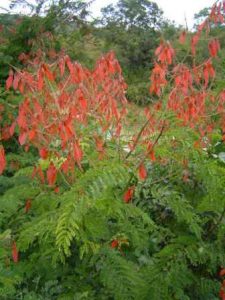
Pterolobium stellatum. Photo: Bart Wursten. Source: Flora of Zimbabwe
There were other unusual trees Euclea racemosa subsp. schimperi with its dark glossy green leaves with a very wavy margin, in the same locality as Euclea divinorum with its diamond shaped brownish leaves. And Anton Ellert found a Euclea crispa in green fruit, one which we did not recognise. There were stands of Diospyros lycioides through which we followed or stopped along cattle paths. Pterolobium stellatum the redwing was prevalent, beautiful in the sunlight but not so enthusiastically admired when caught on the skin.
Combretum erythrophyllum with its characteristic “claw” marks on the trunk and Celtis africana with it very smooth bark must have been there for decades to reach the size which they had attained. In the afternoon we moved away from the stream and wandered along the edge of the hill. Once again there was much of interest, Pleurostylia africana with little green fruits, Bauhinia petersiana, the white Bauhinia with pods more round at the end then the red Bauhinia, Bauhinia galpinnii which we had seen in flower in the morning. Ximenia caffra with its rounder hairy leaves was very different from Ximenia americana with its blue-green smooth leaves and so we had no difficulty distinguishing between the two.
We returned home via Lions Head. It is incredible how lion-like this rock formation is.
-Cheryl Haxen
BINGA SWAMP FOREST
A combination of generous rains and grazing control has improved conditions in and around the forest, there is some promise in the number and variety of saplings emerging to succeed the climax trees, the forest floor is carpeted with forest grass (Oplismensis) and a variety of herbs (with Desmodium predominant), and tranquillity and bird song await those who care to travel the 30km from Salisbury.
During the visits in recent months, our President and Mr. Paul Richards of Henderson Research Station and I have been tempted to “lay on” a visit by Society members; mostly for the enjoyment it would afford but partly, I must confess, to rally as many hands as possible to deal with the flush of new Mauritius Thorn seedlings which each rainy season produces. We felt in the end that we had to deny members the pleasure of pulling thorn seedlings, even though Meg had formulated some diabolical plan of offering beers and other bribes for outstanding zeal. As it happened, the rains continued, excessive trampling within the forest might not have been wise, the track from the main road was rough, the grass on the approaches was rank. For all these reasons we decided it might be best for the time being, to confine the seedling attack to a relatively small working party.
Just such a party converged on the forest on Sunday 10th May and, largely through the cheerful assistance of garden and farm helpers on overtime rates, made what we hope was a fairly thorough job of clearing the young thorn.
It was a pleasant day, with the work aspect by no means oppressive or fatiguing, and we hope that later in the year members will respond in large numbers to an invitation to spend a day in this delightful retreat. There should be no discomfort from thorn for the rest of the year.
I should like to acknowledge the fact that the easy pace of the operation of the 10th May was due in no small measure to three very successful spraying expeditions mounted by the Henderson Station’s Weed Research Unit, one in December, one in January and a third in April. The first was aimed at checking thorn and other aliens, the second concentrated mainly on a Syringa explosion, and the third dealt largely with concentrations of emerging thorn seedlings. Spraying operations, of course, have maximum impact (and do minimum harm) when directed at concentrations of unwanted plants. The removal of isolated seedlings or isolated groups of seedlings is much better done by hand. Hence the May visit, at which it was particularly pleasant to welcome, from Henderson Mr and Mrs Richards and Mr and Mrs Shepherd and members of their families and to greet, again those staunch Binga enthusiasts Stan and Rene Carey and their guests.
There is a possibility of further developments connected with the hoped for re-establishment of wet vlei conditions surrounding the forest. This will take time and care. If a Society outing can be arranged later in the ear, the N.R.B.’s tentative plans can be given in more detail, and members might care to discuss them.
-R.W.Petheram
Paul and I were introduced to members of the Matabeleland Branch at a visit to Mabukuwene during the Easter holiday. Unfortunately Miss Janet Webber was not there, she did however, provide this introduction:
Mabukuwene, THE BURIAL PLACE OF Thomas Meikle was handed over to the National Trust by Mrs. J. Rudrup, on behalf of Meikles Trust in March, 1979, in a moving ceremony, particularly when she spoke of her father and said what a retreat the area had been when business matters pressed heavily on him. The grave area is walled off, but the rest was an interesting wilderness at that stage. Financed by the Meikles Trust and arranged by the Aloe Society, it has now been fenced, the gates have been erected in a fine stone wall. The summer house has been repaired and rethatched and a serving counter installed for use at meetings; braai fireplaces have been provided, paths cut and other works carried out. There are many heavily wooded kopjes, a gazebo (not too many of these are seen in flat Matabeleland), and a summer stream – all in a small area with the city boundary.
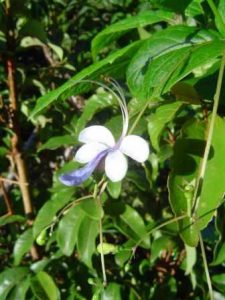
Clerodendrum myricoides. Photo: Bart Wursten. Source: Flora of Zimbabwe
There are some very fine trees there such as Acacia sieberiana, Parinari curatellifolia, a tremendous Ficus glumosa and Pterocarpus angolensis –some of the 100 shrubs and trees. The Tree Society has tagged trees in the central area. There are 8 different acacias, 14 fruit bearing trees, some trees with aromatic leaves and beautiful flowering ones e.g. Turrea nilotica, Securidaca longipedunculata, Bolusanthus speciosus and Clerodendrum myricoides. It would be a good place to study plant parasites for there are heavy growths of Viscum and Loranthus. The vegetation has the wide variety expected of a granite well drained area, and there are some not as common species such as Grewia retinervis, Euclea undulata, and the large grey leaved Ipomea verbascoides knits it all together on the kopje slopes.
No one had ever seen such a fungus as was seen in January, a brilliant Cathra rubis the size of a small football; some people passed it by thinking it to be a discarded plastic object. The interstices were about 1.5 cm and it is said that flies feed on the glutinous substance inside, which contains spores.
I wonder if the rock hares are still there, and the Spotted Eagle Owls, now that the shady retreats among the rocks have been opened up. The Hawks, Loeries and Shrikes are no doubt still there and more sunbirds than before due to the many Aloes which have been planted. It is a good area for Sixth Form Ecology classes, and very accessible. One day there will no doubt be an Interpretive Centre there.
For those who may be in Bulawayo I can thoroughly recommend a visit to Makukuwene, at the junction of Chipping Way (off Burnside Road) and Inverleith Road.
Although we were given a check list we were so fascinated by the trees that I forgot to tick them off and I am afraid I don’t remember exactly where they all are as we also visited Matopos, Hillside Dams and Ailsby-Kalahari sand – all in three days. It was all very thrilling. No wonder there is a flourishing branch of the Tree Society in Matabeleland. There is certainly a wonderful variety of trees.
-Meg Coates Palgrave
THE ZIMBABWE SCIENCE NEWS VO. 15, NO. 4, APRIL 1981.
The main subject of this issue is Lake McIlwaine – a report back on the anti pollution measures taken in the last ten years and future prospects. Article titles are: Ecological disaster averted; Wastewater treatment; chemistry of the Lake; Water hyacinth; Fish.
Indigenous Trees by Trevor Gordon – species presented – Gardenia posoquerioides
TREASURER’S REPORT
The Treasurer reports that there are still about 30 members whose 1981 subscriptions are not paid. If a cross has been drawn in this space you are on the list of those he would like to hear from if only to tell him he is wrong. If this warning is not heeded you may not get the next Tree Life and we hope you would not want that to happen.


